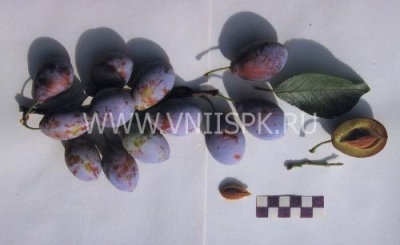
- Authors: R. V. Korneev, L. N. Zhukova (Nizhnevolzhsky Research Institute of Agriculture)
- Appeared when crossing: Heroic x Volgograd
- Year of approval: 2002
- Growth type: medium-sized
- Crown: round, spreading, medium density
- Fruit size: above the average
- Fruit weight, g: 30-35
- Fruit shape: oval, one-dimensional
- Fruit color: violet-brown
- Skin : with a strong waxy coating
Plum is a culture that does not require special care skills, while having an amazing taste and useful properties. However, earlier these were mainly plants of the same type. Domestic breeders have significantly enriched the varietal composition of the plant in recent years. This is evidenced by the plum Vengerka Korneevskaya.
Description of the variety
A medium-sized tree, reaching a height of 3-4 m. The rounded crown is not very dense, but rather spreading. The shoots are curved of gray-brown shade, the bark on them is glossy-smooth. Branches grow from the trunk at a 45 degree angle.
The leaves are medium in size, their shape is obovate, the color changes from dark green to light green. They are rather coarse and corrugated, with slight pubescence. White, small inflorescences are formed with one, two and three flowers. The life span of a tree is 12-15 years.
Fruit characteristics
The fruits are not very large, the mass of one cream reaches 30-35 g. The color is violet-brown, with a thick waxy bloom. Their shape is oval and one-dimensional. The abdominal suture is inconspicuous. Small subcutaneous points are almost invisible. The pulp is very juicy and tender, the consistency is cartilaginous. The bone is freely separable.
Taste qualities
The taste is dominated by sweetness. On a five-point tasting scale, the variety is rated at 4.5 points. The fruit contains a large amount of dry substances, fruit sugars and acids. A small amount of ascorbic acid in the peel gives a delicate sour aftertaste. Appointment in cooking at Hungarian Korneevskaya is universal. High transportability.
Ripening and fruiting
Plum begins to bear fruit 3-4 years after planting. Subsequent fruiting is regular. The variety belongs to the mid-late ripening period. Flowering begins in early May and lasts about 2 weeks. The fruits ripen from the 2nd decade of August to the 1st decade of September.

Yield
The plant is high-yielding. On average, 25-30 kg or 116 kg / ha can be harvested from one tree.
Growing regions
Plum can be cultivated in all regions of Russia. The variety shows its fruitful ability best when grown in the Central Black Earth Region.
Self-fertility and the need for pollinators
The variety is self-fertile. There is no need to plant additional plants for pollination near the crop.
Growing and care
For a seedling to tolerate planting well, choose 1- or 2-year-old specimens.Such a plant has a well-developed root system, so a young tree will quickly take root in a new place.
Plum Vengerka Korneevskaya is unpretentious in care, however, in order to get bountiful harvests, it is necessary to take into account some varietal preferences in cultivation.
For planting, choose an area that is as illuminated and well ventilated as possible. The main thing is to provide that there is no close occurrence of groundwater. The roots do not tolerate flooding at all.
Planting a tree is preferable in the spring. During this period, young seedlings will have time to take root, grow shoots and successfully survive frosts. The planting hole depends on the volume of the root system. As a rule, its depth is at least 80 cm, width - 50 cm. A drainage layer is laid at the bottom of the hole, then humus, wood ash, phosphorus-potassium fertilizer are added. After it is watered abundantly.
The landing procedure is standard. The root collar of the Hungarian Korneevskaya is left 5 cm above the soil level. After irrigation, the soil will settle and it will fall into place. At first, the tree requires constant irrigation. The soil should be moist, but not waterlogged.
Before the beginning of fruiting, the trees of the variety are annually sanitary and molding pruning. As soon as the crop begins to yield, the trees rejuvenate by removing excess growth, dried, broken shoots.
After planting, the plum Vengerka Korneevskaya does not need additional nutrition for several years. Organic dressings are applied no more than 1 time in 3 years, and mineral dressings can be fed more often. The plant especially needs trace elements such as phosphorus and potassium.




Disease and pest resistance
Hungarian Korneevskaya is distinguished by persistent immunity to most diseases of fruit trees. Pests practically do not affect the tree.

Despite the fact that plum is considered more hardy than many fruit trees, it is not immune from diseases. It is attacked by viral, fungal and bacterial infections, and parasitic insects harm it. It is necessary to notice and recognize the signs of plum disease in time. They are easier to deal with and defeat early on. Well, in order to protect the garden tree from such a misfortune in the future, preventive procedures can be carried out.
Resistance to soil and climatic conditions
The culture prefers to grow on fertile soils. Does not tolerate excessively acidic soil. The variety is frost-resistant. In severe frosts from -20 degrees, wood may freeze. Spring return night frosts, which can lead to partial freezing of fruit buds, are of great danger. And also the plant is drought-resistant, especially if apricot was used as a rootstock.



































































